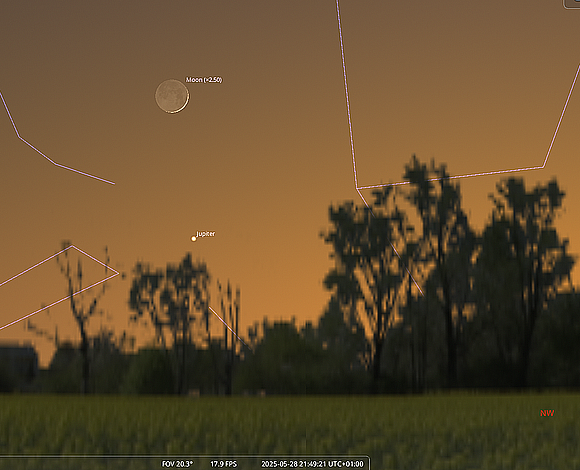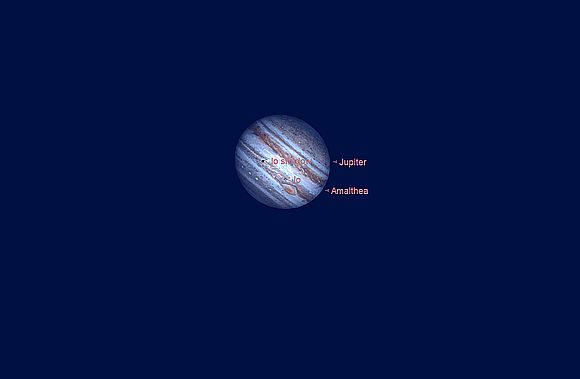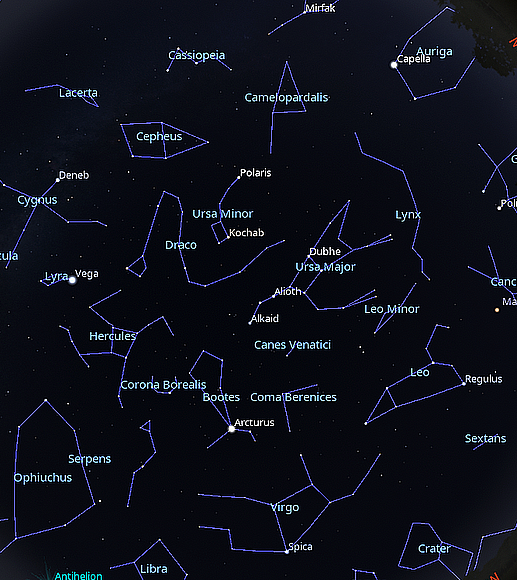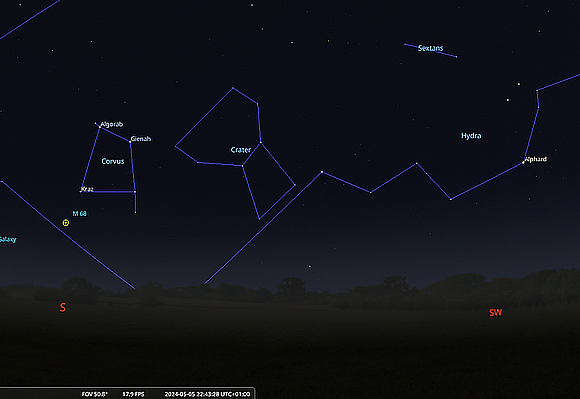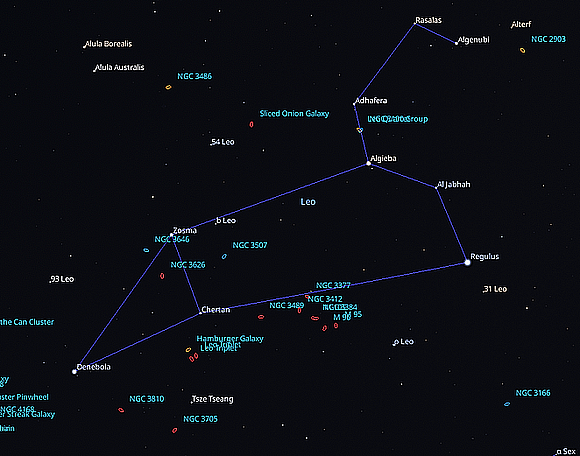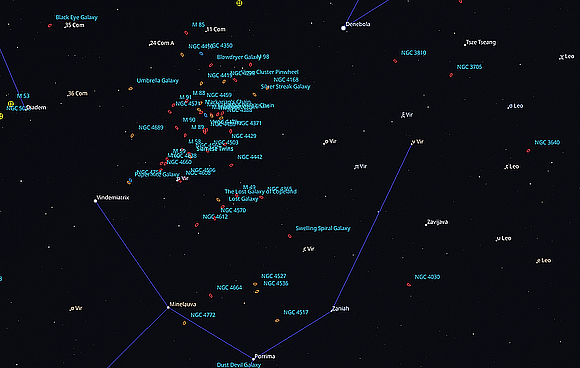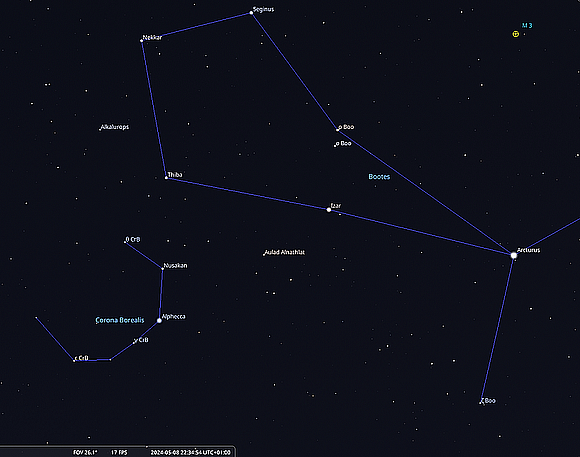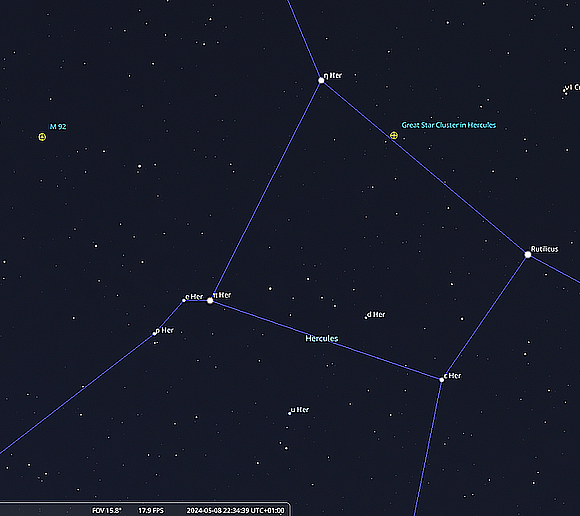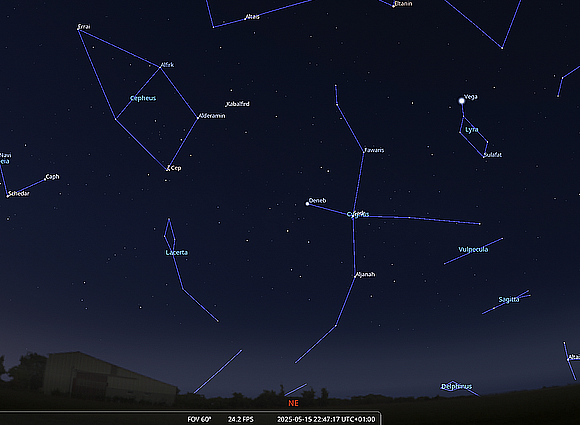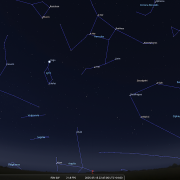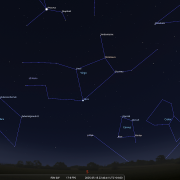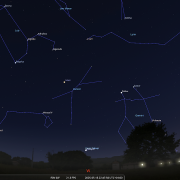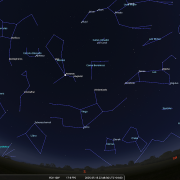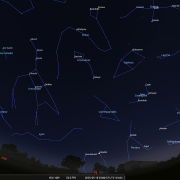In this month's Sky Notes:
Planetary Skylights: A Brief Guide to April's Night Sky
Both Jupiter and Uranus depart the evening sky this month leaving Mars as the sole evening planet. Venus and Saturn are present in the dawn sky, but only Venus will cut through the bright twilight.
 Jupiter finally succumbs to bright twilight and the WNW horizon, departing the evening sky shortly before the end of May. Initially, Jupiter will remain prominent to the naked eye as it descends toward the horizon but becomes increasingly challenging for telescopic observations as the month progresses. Certainly, by the time skies are adequately dark Jupiter is already low, setting after 23:00hrs.
Jupiter finally succumbs to bright twilight and the WNW horizon, departing the evening sky shortly before the end of May. Initially, Jupiter will remain prominent to the naked eye as it descends toward the horizon but becomes increasingly challenging for telescopic observations as the month progresses. Certainly, by the time skies are adequately dark Jupiter is already low, setting after 23:00hrs.
When observed through a telescope, Jupiter provides a notable view. As Jupiter moves towards the northwestern horizon, the image quality or 'seeing' will decrease due to increasingly unstable air. Observers should still be able to see the dark equatorial belts across the oblate disk, as well as the Galilean moons appearing as small specks of light in Jupiter's equatorial plane. Larger telescopes may initially show additional details, including the Great Red Spot, a large storm system that is now a third smaller in size and considerably paler than it was a few decades ago. The optimal dates for viewing this feature are May 1st, 6th, 8th, 13th, 15th, 18th, and 20th, all between 21:30hrs and 22:30hrs.
The dynamic orbits of Jupiter's Galilean moons provide an excellent opportunity for observation, particularly during shadow transits. There are limited transit events visible in May, with the most favourable occurring on May 6th when Io's shadow will be observable near the Great Red Spot at approximately 21:30 hours. A telescope with a 100mm (4") aperture and high magnification should be adequate, although instruments with a 150mm (6") aperture are preferable.
 Mars begins the month in close proximity to the open cluster M44, also known as Praecipe or the Beehive in Cancer. Observe as Mars grazes the northern outskirts of the cluster during the first week of May. The view is further enhanced by the presence of a quarter Moon in the immediate vicinity on May 4th. To the naked eye, Mars appears no brighter than an average first-magnitude amber star, and by the month's end, it is less conspicuous than Pollux in Gemini (magnitude +1.15) and exhibits a similar hue. By the 24th, Mars departs from Cancer and crosses into Leo.
Mars begins the month in close proximity to the open cluster M44, also known as Praecipe or the Beehive in Cancer. Observe as Mars grazes the northern outskirts of the cluster during the first week of May. The view is further enhanced by the presence of a quarter Moon in the immediate vicinity on May 4th. To the naked eye, Mars appears no brighter than an average first-magnitude amber star, and by the month's end, it is less conspicuous than Pollux in Gemini (magnitude +1.15) and exhibits a similar hue. By the 24th, Mars departs from Cancer and crosses into Leo.
The Martian disk will appear very small when viewed through a telescope, measuring less than 6 arc-seconds in diameter. Only substantial backyard telescopes with apertures of 300mm or larger will be able to reveal any surface detail. Although Mars will remain visible in the evening sky, its prominence will diminish as the evenings become progressively lighter, making it less noticeable to the naked eye.
 Having transitioned from evening sky to the dawn sky, Venus will remain quite challenging to spot for many people just above the East horizon before sunrise, in fact its entire morning apparition is rather low key for mid-northern latitudes. It doesn't help that dawn arrives ever earlier and an observer will need to be up by 04:30hrs to spot it. The observing window is initially rather limited, and it may be better to wait until the end of the month when Venus has pulled away a little from the horizon, although even then it is just 6 degrees above it.
Having transitioned from evening sky to the dawn sky, Venus will remain quite challenging to spot for many people just above the East horizon before sunrise, in fact its entire morning apparition is rather low key for mid-northern latitudes. It doesn't help that dawn arrives ever earlier and an observer will need to be up by 04:30hrs to spot it. The observing window is initially rather limited, and it may be better to wait until the end of the month when Venus has pulled away a little from the horizon, although even then it is just 6 degrees above it.
At magnitude -4.5 Venus is bright enough, but observing Venus through a telescope will be limiting due to its low elevation, just 6 degrees even at the end of the month. Through a telescope it should be possible to discern a phase, which evolves from 30% to 48% by the months end. On May 23rd a waning crescent Moon lies to the right of Venus at 04:00hrs BST and to the left the following morning.
 Saturn is technically visible in the dawn sky - to the right of Venus but will be exceedingly difficult to spot until it rises in darker skies - which will be early June around 03:00hrs from UK latitudes. Saturn will still be orientated almost edge on, so observations with a telescope will be rather disappointed anyway. A waning crescent Moon passes above Saturn on the mornings of the 22nd and 23rd around 03:45hrs.
Saturn is technically visible in the dawn sky - to the right of Venus but will be exceedingly difficult to spot until it rises in darker skies - which will be early June around 03:00hrs from UK latitudes. Saturn will still be orientated almost edge on, so observations with a telescope will be rather disappointed anyway. A waning crescent Moon passes above Saturn on the mornings of the 22nd and 23rd around 03:45hrs.
May Meteors
The Eta Aquarid meteor shower is this month's major shower with peak activity falling in the predawn hours of May 6th. Considered a strong shower from more southerly latitudes the ZHR can be as high as 50 or so. From the UK the shower's radiant is quite low with Aquarius only just rising in the early morning hours at this time of year, observed rates being in the 10-15 per hour bracket. The Eta Aquarids is one of two meteor showers associated with debris particles deposited over time by comet Halley, the other shower being the Orionids seen in late October. Eta Aquarids are some of the swiftest meteors at 67km/s or 41miles/sec. View to the east, south, and high to the southeast around 03:30hrs and you should hopefully spot a few bright examples. Moonlight from a setting first Qtr. Moon will have little impact.
Noctilucent Cloud/Aurora/T Cor B
The end of May is normally the start of the Noctilucent cloud season (more on this next month), so do keep a watch post 23:00hrs for blue filamentary cloud structures above the northern horizon.
Our Sun remains active and therefore the chances of there being auroral activity also continues. After a lull in activity, April has seen some strong displays, frustratingly two were during daylight hours with another occurring with 80% cloud cover over our region. Do therefore visit the various aurora warning sites.
And finally, the recurrent nova T Cor B has still not erupted keeping astronomers on tender hooks. Reports suggested that it might occur on March 27th - but nothing happened. There is now speculation the outburst could occur at the next 228-day orbital period, which may be Nov. 10th. Failing this, T CrB completes additional orbits on June 25th, 2026, and Feb. 8th, 2027. But then again it could erupt anytime. Keep abreast of the media.
May Night Sky
April 2025 was a far sunnier month and correspondingly the number of observational night sky opportunities also increased. The downside is that hours of darkness continue to erode as twilight margins grow and astronomical twilight (the deepest level of darkness) is lost from UK latitudes during the month, not returning until early August. Constellation recognition becomes increasingly tricky with a viable observing window of little more than 3 hours by the month's end.
The last vestiges of seasonal winter constellations are lost to bright twilight, Canis Minor and Gemini highlighted by the stars Procyon, Castor, and Pollux respectively, last to depart in the west. The circumpolar ‘winter’ star, Capella, in the constellation of Auriga, swings down toward the NW horizon in preparation for its 'summer holiday' low to the north.
All, however, is not lost for the 'star gazer' and by utilising the brighter stars visible and certain star patterns, an observer may still navigate around the night sky. For instance, the familiar Plough or Big Dipper asterism forming the hindquarters of Ursa Major - the Great Bear, is located almost overhead during May. Follow the natural sweep of 3 stars in the handle of the Plough and ‘arc to Arcturus’, the brilliant amber star in Boötes located high in the SSE. Flatten this curve out and then 'speed on to Spica' - chief star in Virgo located down in the south.
Lower right of Spica, note the faint outline of Corvus the Crow, a constellation sometimes known as 'Spica's spanker', referencing the type of sail this outline suggests. To the right of Corvus perpetually out of reach, sits the bird's drinking cup, Crater. These two less prominent, but distinctive star groups ride upon the coils of Hydra - the water snake, the largest constellation in the heavens, which sprawls above the horizon from SE to SW and only just visible in its entirety during the first few weeks of May from the UK.
Higher in SSW stands Leo, the spring skies signature constellation, identified by the ‘sickle’ asterism, a stellar arrangement highlighted itself by Regulus, least brilliant of those 1st magnitude stars visible in the night sky from the UK. The 'sickle' asterism, so named because it resembles the outline of that farming implement, looks like a backwards question mark emanating from Regulus. The hindquarters of Leo are marked by a triangular arrangement of stars with the star Denebola marking the rear point.
Not far below the star, Chertan or Chort within the triangle, lie several galaxies including M65 and M66, as well as NGC 3628. Further west (roughly 2/3rds of the way from Denebola to Regulus) resides another group of galaxies comprised of M95, M96 and M105. All may be glimpsed in a good 100mm (4") telescope.
The area of sky behind Leo and above Virgo has only a smattering of faint naked eye stars. These mark Coma Berenices, a constellation rich in deep sky objects (galaxies mostly) M64, M85, M88, M91, M98, M99 and M100, but also include the messier object M53, a globular cluster. The constellation also contains the Coma galaxy cluster, some 300 million light years distant.
Virgo itself is the largest zodiac constellation and contains many deep sky objects (see in focus - Window on the Wider Universe and Spring Tales) The constellation occupies much of the aspect above the southern horizon during May, its outline somewhat resembles a bowl with a crooked leg (a bit like a distorted ‘Y’ pattern). Above the bowl of the 'Y' many galaxies belonging to the Virgo cluster can be identified in amateur scopes. The whole region of sky bounded by the 'bowl', Coma and the hindquarter of Leo is often referred to as the 'realm of the galaxies', being a window onto the wider universe, well away from intervening galactic gas and dust. Messier galaxies alone within Virgo number eleven; M49, M58, M59, M60, M61, M84, M86, M87, M89, M90 and M104 - the Sombrero galaxy. Should insomnia strike when nights are clear in May, see how many 'fuzzies' you can track down in a telescope.
Later in the month - or towards dawn, the Scales, or Balance of Libra marks the forward boundary of seasonal summer constellations, especially those located on the ecliptic. The ancient Greeks called the stars we now associate as Libra the Chelae, or “claws,” and were considered once as being part of Scorpius. The constellation's brightest stars: Zubeneschamali and Zubenelgenubi have names derived from Arabic phrases meaning 'northern claw' and 'southern claw' respectively. Note the bright orange hue of Antares chief star in Scorpius low to the SSE late in May shortly after 23:30hrs. More to be said on these groups next month, as to the large, but faint constellations covering much of the SE aspect above the horizon; Ophiuchus, Serpens, and Hercules often overlooked during the short light nights of late May, June, and July, but rich in DSO's.
Return now to brilliant Arcturus at the base of the constellation Boötes, the outline of which reminds somewhat of a 'thin kite'. Arcturus is visually the 4th brightest star in the heavens and only surpassed by Sirius from UK shores and is therefore for 8 months of the year, the brightest star visible at mag -0.05. Arcturus is the closest example of an orange giant star, just under 37 light years away, and now aged 7 billion years was once very like our own Sun. Arcturus has the largest proper motion (real motion through space) of any bright star, a rate of 2 arc-seconds per year, cutting across our Sun's trajectory as it orbits around the galaxy. In less than half a million years a telescope will be required just to spot it at all.
Eastwards of Boötes lies the distinctive circlet of stars marking Corona Borealis - the Northern Crown, said to represent the golden crown worn by Princess Ariadne of Crete when she married the god Dionysus (Roman god Bacchus) and made by Hephaestus, the god of fire. The constellation is appreciated best in binoculars. The centre star in the tiara is known as Alphecca or Gemma. Keep watch to the lower left of the circlet for the recurrent nova T Cor B, due to erupt again this year. It will appear as bright as Alphecca (mag +2) should it do so.
The great hero Hercules follows the crown, a large, ill-defined constellation that contains no bright stars and is best identified by the Keystone asterism named after its shape. The constellation does however contain the wonderful globular cluster known as M13 located a third of the way down the right-hand side of the Keystone, marked by eta and zeta herculis. Another fine globular, M92 lies above the keystone stars pi and eta.
Finally, turning to the east, look for the sparkling steely blue hue of Vega in Lyra rising in the ENE after its winter flirtation with the north horizon, and accompanied in the NE lower still by Deneb in Cygnus. These circumpolar summer luminaries are now on the comeback road, the third and non-circumpolar member of the 'summer triangle', Altair in Aquila, will become visible low to the east by mid-month.
Serious deep sky observing may then be difficult and inconvenient, but if conditions are mild and clear it remains a joy just to step outside and admire the ever-changing aspect of the night sky.
May 2025 Sky Charts
Additional Image Credits:
- Planets and Comets where not otherwise mentioned: NASA
- Sky Charts: Stellarium Software and Starry Night Pro Plus 8
- Log in to post comments

